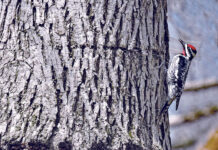
My childhood was spent playing in the woods. Exploring a stream behind our house, catching crayfish, minnows and frogs with my little net was practically a daily ritual.
One thing that stands out in my mind were the encounters I had with stinging nettle. I was almost always in shorts, so the stinging sensation that welled across my legs whenever I unknowingly brushed against the plant was nearly unbearable … until a close friend told me about using jewelweed to ease the pain.
Jewelweed

Jewelweed (Impatiens capensis) is in bloom right now. This native, annual plant, commonly found throughout most of North America is hard to overlook. Growing up to 5 feet in height, it has thick stems that easily buckle if disturbed. Preferring moist habitats, it can often be found thriving along creeks, around the perimeters of wetlands, in ditches or in floodplain forests where it forms incredibly thick stands, sometimes even shading out non-native garlic mustard. The plant’s crowning glory are the beautiful jewel-like flowers which hang profusely from the branching stems.
Jewelweed blossoms come in two colors, a vividly spotted orange and a pale yellow (Impatiens pallida). Close observation reveals an artistic masterpiece, as each flower opens into a large pouch that trails off into a curved spur at the rear. Deep within this narrow structure is an enticing supply of nectar that can only be reached by organisms with long tongues, making the plant a favorite of hummingbirds and bumblebees. To reach the sweet treat, they must push past the pollen-producing structures near the front of the blossom. Acting as a hitchhiker, the pollen sticks to the bird or bee and is then carried along and transferred to other flowers in an effective act of pollination.
Once pollinated, the flowers proceed to set seeds in small downward hanging pods up to an inch in length. As the seeds within develop and grow, the pod begins to swell until finally, a reaction termed “explosive dehiscence” occurs. This is an act of seed dispersal that serves to propel them far out from beneath the parent plant. Just the slightest touch will cause the seed pod to recoil, causing a miniature explosion, powerfully catapulting the seeds out in many directions. It is this surprising reaction that has also earned the plant its moniker of “touch-me-not.” Producing and spreading seeds throughout the summer months will ensure that the plant will thrive once again the following year.
Jewelweed may have also earned its name from the silvery appearance of the underside of the leaves when held underwater. The term “silverleaf” is derived from a leaf’s ability to trap and hold oxygen against itself when submerged. Drops of water also bead on top of the leaves, giving the appearance of shiny jewels.

Soothing abilities
When I see jewelweed, I can’t help but smile. For me, its finest properties lie inside the succulent stems. Breaking the supporting structures open at the thickest nodules will release a clear liquid with the most amazing capabilities for soothing many types of irritations. The discomfort of poison ivy, bee stings, mosquito bites, athletes foot and yes, even stinging nettle have been almost instantly relieved when the juice from the jewelweed stem is applied directly to the affected area.
Io moth

One of the caterpillars I regularly rear every year is that of the Io moth. Although the adults are stunningly beautiful and quite harmless, the caterpillars sport stinging spines that deliver a painful sensation that lasts for hours when coming in contact with the skin. No matter how careful I am, my arm always seems to run into one of these individuals when changing their leaves, leaving me grumpy and miserable for the rest of the day.
One day, while enduring the pain and feeling very sorry for myself, my gaze fell upon the expansive patch of jewelweed blanketing the woods around my house. I couldn’t help but wonder. I wandered over to the plant with the thickest stem. Breaking it open, I vigorously rubbed the juices onto the inflamed area inflicted by the caterpillar’s nasty spines. The relief was nearly instantaneous! Yes indeed, jewelweed truly is a diamond in the rough.

















Here in Southwest Missouri on my late Grandparents farm, Jewelweed is quite abundant in front of the garage and at the bridge where the driveway crosses the south fork of Beamon Branch. I have recently learned about the flowering plant to be medicinal and now an indepth article by Tami Gingerich. Thank you for your knowledge and sharing the info about the outdoors and such.